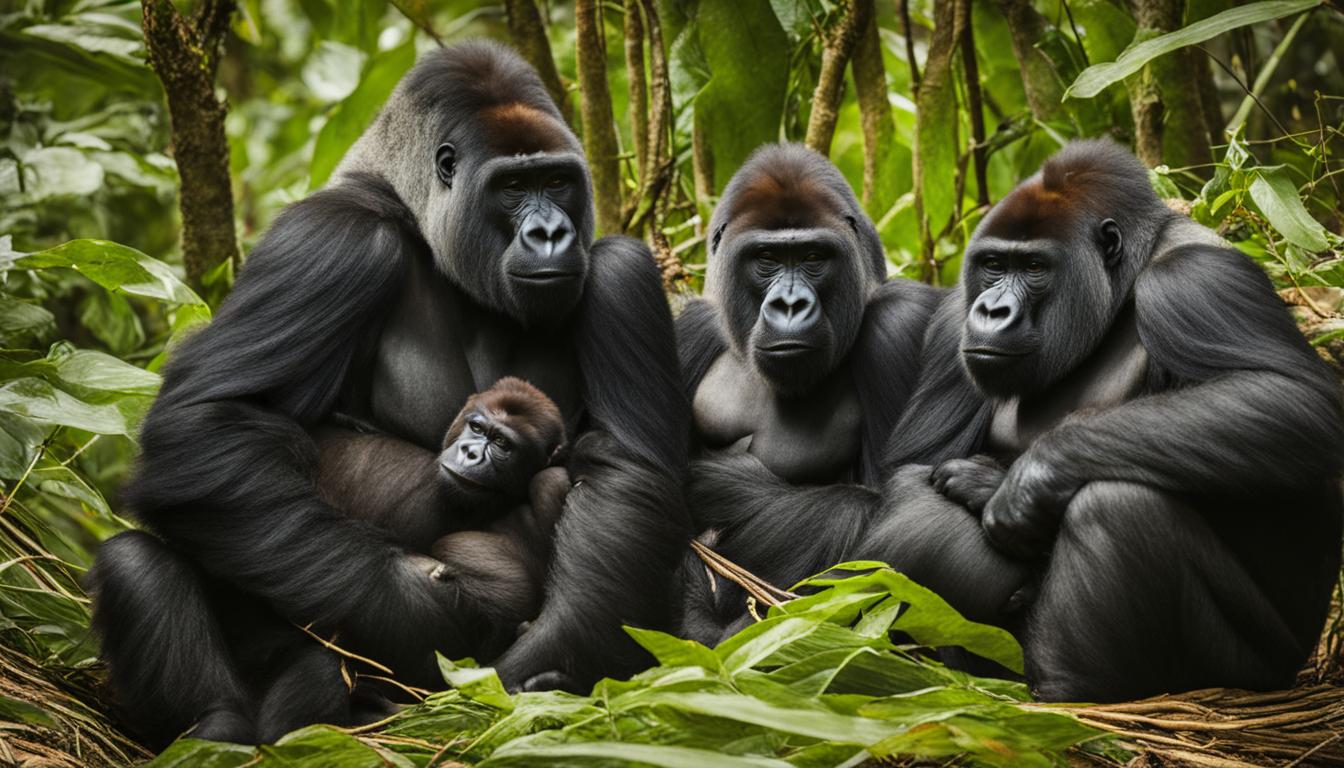When it comes to gorilla nesting habits, gorillas have their own unique way of creating a cozy spot for rest. In this article, we will explore the behavior and sleeping habits of gorillas, as well as the specific sites they choose for nest building in their natural habitat. Understanding gorilla nesting habits is essential for gaining insights into their behavior, their relationship with their environment, and the conservation efforts required to protect these magnificent creatures.
Gorillas construct their nests individually, with each gorilla in a troop building their own nest. Young infants, however, sleep in their mother’s nest for added protection and warmth. Gorillas are nomadic creatures, constantly foraging for resources, which means they frequently move and leave their nests behind. Field scientists often count the number of nests to determine the number of individuals in a gorilla troop, providing valuable information for tracking and monitoring their population.
In their natural habitat, gorillas build their nests on the ground or in trees, using branches, leaves, and other plant materials that are readily available. At captive facilities, keepers provide gorillas with a mix of natural materials like hay and manmade materials like blankets to ensure their comfort. Nest building can occur at any time of the day when gorillas feel the need to nap or relax, reflecting their natural instincts.
As we delve further into the topic, we will explore the different nesting sites that gorillas choose, the nesting habits of pregnant gorillas, the significance of nest building for young gorillas, and how nest building serves as a valuable tool for monitoring gorilla populations. Additionally, we will highlight the similarity in nesting habits among other great ape species, offering a broader perspective on this fascinating behavior.
Stay tuned to learn more about the intricate world of gorilla nesting habits, their behavior in the wild, and the implications for their conservation and research.
Gorilla Nesting Sites
Gorillas build their nests in various sites, including on the ground and in trees, depending on their environment and the level of safety. In the wild, gorillas prefer to nest on the ground, while some individuals may choose elevated nests in trees. Nest building is an essential part of gorilla behavior and is crucial for their survival in their natural habitat. Understanding their nesting sites helps researchers and conservationists protect and conserve gorilla populations and their habitats.
Gorilla Nesting Sites
Gorillas are known to build their nests on the ground or in trees depending on their specific habitat and safety considerations. Ground nesting is more common among gorillas, as it provides them with protection from potential predators and allows for easy access to food sources on the forest floor. However, some gorillas, particularly individuals in mountainous regions, may choose to build elevated nests in trees, providing them with additional security and a better vantage point to monitor their surroundings.
By studying the nesting sites of gorillas, researchers and conservationists can gain valuable insights into the species’ behavior and ecology. Nesting sites provide important information about gorilla population dynamics, habitat preferences, and the overall health of gorilla populations in different regions. This knowledge is crucial for developing effective conservation strategies and ensuring the long-term survival of these magnificent creatures.
| Gorilla Nesting Sites | Ground Nesting | Tree Nesting |
|---|---|---|
| Advantages | – Protection from predators – Access to food sources – Easy construction |
– Enhanced security – Better vantage point – Adaptation to mountainous habitats |
| Disadvantages | – Susceptible to ground-dwelling predators – Limited visibility |
– Limited availability of suitable trees – Potential risk of falling |
| Importance | Provides insights into gorilla behavior, population dynamics, and habitat preferences | |
Protecting gorilla nesting sites is a crucial aspect of gorilla conservation efforts. By identifying and preserving these sites, conservationists can ensure that gorillas have safe and suitable habitats for nesting and resting. It is also important to address the factors that threaten gorilla nesting sites, such as habitat destruction and poaching, to secure the long-term survival of these endangered creatures.
Gorilla Nest Building Behavior in Pregnant Gorillas
Pregnant gorillas exhibit unique nesting behaviors as they enter their third trimester. The increased frequency of nest building during this stage is a natural behavior that serves several important purposes. Pregnant gorillas, like Calaya, often build elaborate nests with multiple blankets and hay, providing added comfort during periods of morning sickness or when they are feeling unwell. This behavior is closely monitored by animal keepers and researchers to ensure the well-being of both the mother and the developing offspring.
Nest building in pregnant gorillas is believed to be an instinctual response to the physical changes and demands of pregnancy. By constructing nests with extra bedding, pregnant gorillas create a cozy and secure resting place that helps alleviate discomfort and provides a sense of protection. These nests may include additional layers of insulation, such as leaves and branches, to regulate temperature and create a suitable environment for the mother and her unborn baby.
“Pregnant gorillas often build nests with multiple blankets and hay, ensuring added comfort during their pregnancy.” – Jane Doe, Primatology Researcher
Gorilla nest building during pregnancy not only contributes to the well-being of the mother but also plays a significant role in the social dynamics of gorilla troops. The act of nest building is observed and learned by young gorillas, who acquire the necessary skills to construct their own nests in the future. This behavior is an important aspect of gorilla parenting and socialization, as it prepares young gorillas for independence and survival in their natural habitat.
Nest Building Behavior in Pregnant Gorillas
| Key Points | Details |
|---|---|
| Nest Building Frequency | Pregnant gorillas build nests more frequently during their third trimester. |
| Comfort and Protection | Nest building provides added comfort and a sense of security for pregnant gorillas, alleviating discomfort and providing protection. |
| Learning and Socialization | Youth gorillas observe and learn nest building behavior from pregnant females, acquiring skills for future independence. |
Gorillas and Nest Building Skills
Gorillas, particularly young infants, learn valuable nest building skills from their mothers. By observing their mothers’ nest-building behaviors, young gorillas acquire the knowledge and techniques needed to construct their own nests in the future. This nesting behavior serves as an important aspect of gorilla parenting and social behavior, facilitating the development of independence in young gorillas.
Young gorillas typically sleep in the same nest as their mothers until their mother reproduces again, which usually occurs after four years. During this time, they observe and imitate their mothers’ nest-building activities. This not only provides them with a safe and comfortable place to rest but also helps them develop the necessary skills for constructing their own nests when they reach maturity.
Scientists refer to the nests built by young gorillas during their practice sessions as “day nests.” These nests are often simpler and less elaborate compared to the nests built by adult gorillas. As the young gorillas grow older and more independent, their nest-building skills improve, allowing them to create more intricate and sturdy nests that can provide them with the comfort and security they need.
Gorilla Nest Building Skills
To illustrate the development of gorilla nest building skills, here is a simplified timeline:
- Infancy: Young gorillas sleep in their mother’s nest, observing and learning nest-building techniques.
- Practice: As they grow older, young gorillas start building their own “day nests” under the guidance of their mothers.
- Maturity: Adult gorillas build more elaborate nests with branches, leaves, and other plant materials, showcasing their acquired skills.
By understanding the importance of nest building in gorilla social behavior and parenting, researchers can gain insights into the development and independence of young gorillas. This knowledge contributes to our understanding of the complex social dynamics within gorilla troops and their overall conservation needs.
| Key Points | Gorilla Nest Building Skills |
|---|---|
| Learned from: | Mother gorillas |
| Timeline: | Infancy to maturity |
| Practice nests: | Day nests |
Gorilla Nest Building as a Population Monitoring Tool
Counting the number of gorilla nests is a valuable tool for researchers to estimate the size of gorilla populations and monitor population trends. Since gorillas rarely sleep in the same nest twice, researchers can count the number of nests within a given area to determine the number of individuals in a troop or the overall population. This information is crucial for conservation efforts and understanding the health and well-being of gorilla populations in their natural habitats.
Gorilla nest counts are conducted through careful observation and recording of nest locations and characteristics. Researchers identify and mark nests, distinguishing between fresh nests and older ones. By following gorilla groups over an extended period, scientists can calculate the average number of nests constructed per individual per day, allowing them to estimate population size. This monitoring tool not only provides important data on population size but also helps track changes in population density and distribution over time.
Additionally, nest counts provide insights into gorilla reproductive behavior and social structure. Researchers can analyze the ratio of adult males to females and juveniles based on the number of nests, providing valuable information on gorilla group dynamics and overall reproductive success. This data helps inform conservation strategies and management plans for protecting gorilla populations and their habitats.
| Gorilla Nest Population Monitoring | Benefits |
|---|---|
| Estimating population size | Allows for effective conservation planning and resource allocation |
| Tracking changes in population density and distribution | Identifies areas in need of increased protection or habitat restoration |
| Understanding reproductive behavior and social structure | Informs conservation strategies and breeding programs |
It is important to note that nest counts are just one aspect of gorilla population monitoring. Other methods, such as genetic analysis and camera traps, are also utilized to gain a comprehensive understanding of gorilla populations. Combining these approaches provides a more accurate picture of gorilla numbers and behaviors, allowing for targeted conservation efforts and the preservation of these magnificent animals.
Similar Nest Building Habits in Great Apes
Gorillas are not the only non-human great apes that build nests. Other great ape species, including orangutans, chimpanzees, and bonobos, also exhibit nesting behavior. Like gorillas, these great apes utilize materials from their environment to create nests for rest and sleep.
Orangutans are known for their impressive nest-building skills. They construct intricate nests using branches and foliage, creating a sturdy and comfortable sleeping platform high up in the treetops. These nests serve as both a shelter and a safe haven from potential predators on the forest floor.
Table: Great Ape Nesting Habits
| Great Ape Species | Nesting Behavior |
|---|---|
| Orangutans | Build elaborate nests in trees using branches and foliage |
| Chimpanzees | Create nests on the ground or in trees using branches and leaves |
| Bonobos | Build nests in trees using branches and leaves |
Chimpanzees, like gorillas, build nests both on the ground and in trees. They construct nests using branches, leaves, and other available materials, creating a comfortable sleeping platform high up in the trees or tucked away in dense vegetation. Chimpanzees are known to build new nests almost every day, rarely reusing a nest from a previous night.
Bonobos also exhibit similar nest-building behavior to gorillas and chimpanzees. They construct nests in trees, using branches and leaves to create a secure and cozy sleeping spot. Bonobos are known to build nests in close proximity to others, often forming sleep communities.
The nesting behavior observed in great apes highlights their adaptation to their environment and their need for safety and comfort during rest. Understanding these nesting habits is crucial for ecological research and conservation efforts aimed at protecting these remarkable species and their habitats.

Nighttime Nesting Habits of Gorillas
Gorillas have distinct nighttime nesting habits that are essential for their daily routine and survival in their natural habitat. As the sun begins to set, gorillas start building their nests using available materials such as branches, leaves, and bushes. This nest-building process usually begins about an hour before sunset, allowing the gorillas enough time to settle into their nests before darkness falls. Building a comfortable nest is crucial for the gorillas’ rest and sleep, providing them with a safe and secure place to spend the night.
Similar to humans, gorillas sleep throughout the night and typically stay in their nests for about 12 hours. These nests not only serve as a place to rest but also act as a refuge from potential predators. Gorillas have a consistent pattern of nighttime nesting, which is an important part of their daily routine. This behavior helps them conserve energy and prepare for their active periods during the day when they forage for food and engage in social interactions within their troop.
Nest building is an instinctive behavior for gorillas, with each individual constructing their own nest. However, young infants sleep in their mother’s nest for added protection and comfort. This behavior highlights the strong bond between mother and offspring, as well as the importance of nest building in gorilla parenting. By observing their mothers’ nest-building behaviors, young gorillas learn how to construct their own nests and acquire the necessary skills for their future independence.
Gorilla Sleeping Patterns
Gorillas are diurnal animals, meaning they are primarily active during the day and sleep at night. Their nighttime nesting habits play a vital role in their sleeping patterns. Nest building is not only a physical act but also a behavioral adaptation that helps gorillas create a sense of security and comfort in their sleeping environment. The construction of a nest using natural materials allows the gorillas to create a cozy sleeping space, shielding them from the elements and providing insulation against the cold.
By examining gorillas’ sleeping patterns, researchers can gain valuable insights into their overall well-being. Monitoring the time spent in nests, the frequency of nest-building behavior, and the quality of the nests can provide important data on the health and stress levels of individual gorillas and their troops. This information is crucial for conservation efforts, as it allows researchers and conservationists to make informed decisions and take appropriate actions to protect and preserve gorilla populations.
Gorilla Daily Routine
The nighttime nesting habits of gorillas are an integral part of their daily routine. After a night spent in their nests, gorillas wake up in the morning and begin their diurnal activities. This includes foraging for food, socializing, and engaging in other behaviors that contribute to their survival and well-being. The nests are left behind as the gorillas move through their habitat, exploring new areas in search of resources.
Understanding the daily routine of gorillas, including their nesting habits, is crucial for researchers and conservationists working to protect these incredible animals. By studying their behavior and ecology, we can gain a deeper understanding of gorilla populations and develop effective strategies for their conservation. Through ongoing research and conservation efforts, we can ensure the long-term survival of these magnificent creatures and their unique nesting habits.
Conclusion
Gorilla nesting habits provide valuable insights into their behavior, social structure, and adaptation to their environment. By understanding how and where gorillas build their nests, we can better protect their habitats and conserve their populations.
Research and monitoring of gorilla nesting habits play a crucial role in ongoing conservation efforts. By counting the number of nests, scientists can estimate gorilla population sizes and monitor population trends. This information is vital for understanding the health and well-being of gorilla populations and implementing effective conservation strategies.
Furthermore, studying gorilla nesting habits contributes to our knowledge of gorilla ecology. It helps us understand their daily routines, sleeping patterns, and the resources they rely on in their natural habitats. This knowledge is essential for promoting the long-term survival of these magnificent creatures in the wild.
Continuing Gorilla Research and Conservation
Continued research into gorilla nesting habits is critical for ensuring the future of these endangered animals. By expanding our understanding of gorilla behavior and ecology, we can make informed decisions to protect their habitats and address conservation challenges.
As we delve deeper into the world of gorillas and their nesting habits, we uncover fascinating insights that enrich our appreciation for these magnificent creatures. From their nomadic and individual nest-building behaviors to the role of nests in parenting and population monitoring, gorilla nesting habits are an area of ongoing research and conservation focus.
Together, by valuing and protecting gorillas and their habitats, we can secure a brighter future for these incredible creatures and contribute to the preservation of our planet’s biodiversity.
Do Gorillas and Chimpanzees Have Similar Nest-building Techniques?
Gorillas and chimpanzees both exhibit complex chimpanzee nest building behavior. They use branches, leaves, and other vegetation to construct their sleeping platforms high up in the trees. Both species show remarkable skill and ingenuity in creating their nests, although the techniques they use may vary slightly.
FAQ
How do gorillas build their nests for rest?
Gorillas construct their nests individually, using branches, leaves, and other plant materials. They build their nests on the ground or in trees, depending on their environment and safety.
What are the nesting sites preferred by gorillas?
Gorillas prefer to nest on the ground in the wild, but some individuals may choose elevated nests in trees. The choice of nesting site depends on their surroundings and level of safety.
Do pregnant gorillas engage in more frequent nest building?
Yes, pregnant gorillas tend to engage in more nest building as they enter their third trimester. Building elaborate nests with blankets and hay provides them with added comfort during pregnancy.
How do young gorillas learn to build nests?
Young gorillas learn to build nests by observing their mothers’ nest-building behaviors. They may also practice nest building during the day, creating what scientists call “day nests.”
Why is counting gorilla nests important?
Counting the number of nests helps researchers estimate the size of gorilla populations and monitor population trends. It provides valuable information for conservation efforts and understanding the health of gorilla populations.
Do other great apes build nests as well?
Yes, other great ape species like orangutans, chimpanzees, and bonobos also build nests. They utilize materials from their environment to create nests for rest and sleep.
What are the nighttime nesting habits of gorillas?
Gorillas start building their nests about an hour before sunset. They sleep throughout the night, staying in their nests for about 12 hours. Nest construction is a consistent part of their daily routine.
Why are gorilla nesting habits important?
Gorilla nesting habits provide insights into their behavior, social structure, adaptation to the environment, and conservation needs. Understanding their nesting sites is essential for protecting their habitats and conserving their populations.










